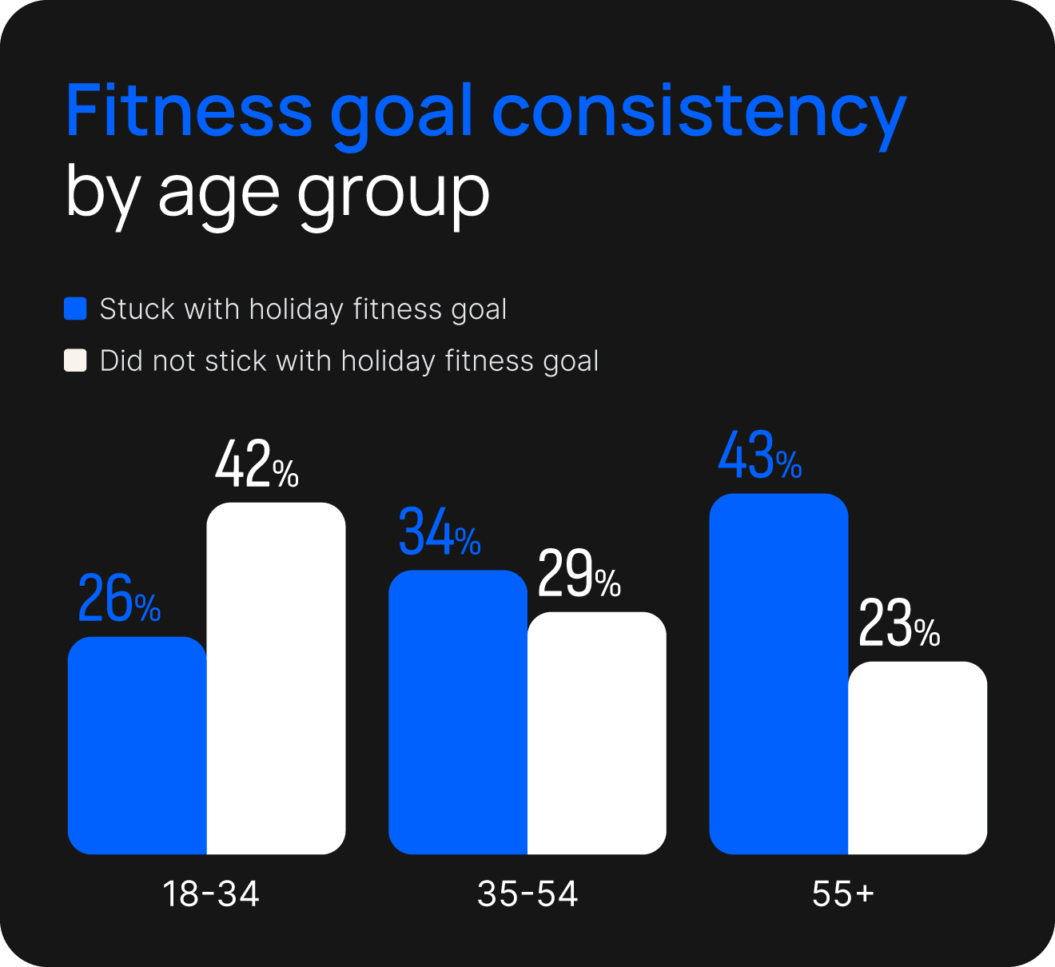America’s $2 trillion wellness economy, which accounts for nearly 32% of global wellness spending, reflects a strong national focus on maintaining long-term health and well-being. Yet despite this massive financial investment, many Americans struggle to stay consistent with their fitness routines.
For many, the challenge isn’t access or cost — it’s staying motivated. Burnout, boredom, and decision fatigue make consistency difficult, pushing people toward short-term fixes like gadgets instead of long-term solutions like fitness memberships.
For fitness creators, this gap presents a major opportunity. Data from our survey of 1,257 American adults shows that many struggle to stay consistent, reinforcing the value of online fitness communities that provide accountability, support, and engagement to help sustain healthy habits.
In this report, we’ll not only unpack the data but also share key takeaways on how to turn these insights into growth opportunities that build stronger, more engaged fitness communities.
Key takeaways
- 30% of Americans set fitness goals but don’t stick to them.
- Among Americans who reported obstacles to staying consistent, the top reasons were lack of time, motivation, and access.
- Gym memberships, at-home equipment, and athletic apparel remain the most common holiday fitness purchases.
- 14% of holiday fitness buyers chose digital fitness content
- 32% of Americans say convenience and access to exclusive content would motivate them to try online fitness programs.
Nearly Half of Goal-Setters Struggle to Stick With Their Fitness Resolutions
Roughly 96 million U.S. adults planned to prioritize health, fitness, or exercise in 2025. But sticking with those goals isn’t always easy.
Among the adults in our survey who recall whether they stuck to their resolutions in the past two years, 46% reported not completing them, just under half of all goal-setters. This highlights how challenging long-term consistency can be, even for people who begin the year highly motivated.
Still, the desire to improve remains strong. Of those who set goals last year, our study found 22% plan to set them again in the coming year, showing that even when resolutions fall short, many Americans are willing to try again.
Staying consistent with fitness goals during the holidays comes down to planning and flexibility. Even short, manageable workouts or active family activities can keep momentum going, and setting realistic expectations helps prevent burnout and frustration.
The struggle looks a little different depending on age. Younger adults (ages 18-34) may find it harder to maintain consistency, while those 35+ often stick with their goals. Fitness tends to become a higher priority as we age, which makes the early years a crucial time to build lasting habits.

Not completing a goal doesn’t reduce motivation, so for fitness creators, this is an opportunity.
By making workouts accessible, engaging, and supportive, younger audiences are more likely to build routines that stick.
Nearly two-thirds cite motivation and other barriers as key challenges
Maintaining fitness routines can be hard, especially for younger adults who are still building habits. In our survey, of the Americans who reported facing barriers to long-term fitness habits, 20% said low energy or lack of motivation is their biggest challenge. It’s easy to see why with busy schedules and day-to-day responsibilities often push fitness to the back burner.
For fitness creators, this is an opportunity. Fostering online fitness communities provides accountability and support, keeping people engaged and consistent with their routines.

Obstacles can fall into three main categories:
1. Motivation and mindset
Staying mentally engaged is tough when progress feels slow or routines become repetitive. As time goes on, many people notice:
- Low energy or motivation
- Boredom or loss of interest
- Lack of challenge or long-term engagement
- Not seeing quick results
Creators can directly influence these behaviors by consistently delivering engaging, interactive content that keeps workouts fresh and motivates people to stick with their routines.
2. Time and lifestyle conflicts
Busy schedules, work, and family commitments make it difficult to exercise consistency. These issues only increase with age as people take on more responsibilities. For example, 77% of parents with children under 18 say that there are obstacles keeping them from making long-term habits from New Year’s resolutions.
For creators, the takeaway is to design content that fits busy lifestyles. Workouts of different lengths or modular programs let users stay consistent, even with limited time, and help them develop long-term habits.
3. Access and resources
Limited access to facilities or financial constraints can also make it harder to stick with fitness plans, though these barriers are reported less often than motivational or lifestyle challenges.

Motivation sits at the heart of these obstacles, and creators can make a real difference by delivering content that’s accessible anytime, anywhere. Whether through digital video catalogs, live-streaming workouts, or a Pilates app, flexible experiences help people build consistent habits.
Gym memberships remain popular, while digital fitness grows as a flexible option
Although many Americans are moving away from traditional gym memberships, flexible fitness options like digital fitness content are a growing trend. In our survey, we found that 38% of Americans report typically purchasing any fitness product or service during the holiday/New Year season, with digital and streaming content making up 14% of those purchases.
Though it’s a smaller slice of holiday spending, digital fitness is making a meaningful impact. According to our Digital Fitness Membership Report, hybrid fitness grew 41% between 2020 and 2022, and most users now prefer a 60:40 split between in-person and digital training. This highlights the demand for flexible fitness solutions, where creators can combine digital content with in-person experiences to reach and engage their audiences.
Our report also found that subscribers remain engaged for an average of 16 months. This shows that fitness memberships provide a longer-lasting impact on consistency than short-term motivators like shoes, gear, or trackers.
Creators can use digital memberships to bridge the motivation gap, pairing them with one-time purchases to help audiences establish and sustain healthy habits over time.
Holiday fitness purchases: what people buy
Among the 38% of Americans who typically purchase fitness-related products or services during the holiday season, here’s what they typically buy:

Holiday shopping often centers around items that offer a quick burst of motivation, like new shoes, gear, or a fitness tracker. But without a structured program, that motivation fades quickly.
For creators, this is where opportunities arise. Memberships, virtual classes, and digital programs help turn initial excitement into consistent routines and long-term results.
Meanwhile, accessories like fitness trackers can enhance engagement when integrated with their content. By focusing on motivation and habit-building, creators can make fitness accessible and sustainable for their audiences.nd sustainable for their audiences.
How creators can inspire lasting fitness habits
Many people struggle to turn intentions into lasting habits. To stay motivated, people often turn to gear or equipment, especially around the holidays. While these purchases can spark interest, motivation often fades without ongoing guidance or support.
Communities help people stay consistent by providing accountability and encouragement to keep going. Convenience is also important: In our survey, about 23% of Americans said at-home workouts would motivate them to join an online program, while 9% said they were interested in exclusive content, like community challenges.
Platforms like Uscreen make it easy for creators to offer virtual classes, modular programs, and community-driven challenges that provide structure, accountability, and engagement. Launching or running holiday promotions can further boost performance. Uscreen data shows:
- Creators on Uscreen earned $100M+ during the 2024 holiday season.
- Launches before January see 10%-20% higher success rates.
- Creators who launch during the holiday surge earn 3-4x more revenue than those who wait until after December.
To engage new members, incorporate community challenges that encourage ongoing participation and design content that integrates accessories or tools when relevant.
For example, Pilates & Yoga with Katja used Uscreen’s community features, including comments, direct messaging, and a private forum, to give members a space to ask questions, share wins, and connect. These features helped grow membership by 10% and boost engagement by 9%, keeping members motivated and improving retention. membership by 10% and boost engagement by 9%, keeping members motivated and improving retention.
Being able to talk with everyone in one place keeps them motivated — way more than YouTube comments ever did.
Building on Katja’s success, yoga creators can use these insights to shape future digital experiences that help users turn initial motivation into lasting fitness habits, making their content both impactful for members and sustainable for their business.
Turn motivation into momentum with Uscreen
Helping people stay motivated is a huge opportunity for fitness creators. You can turn short-term interest into lasting habits by providing engaging content and structured support.
Uscreen makes this easier by offering a platform to grow your health and wellness community. Use live streaming, modular programs, and community tools to become a reliable source of fitness motivation while building a sustainable, supportive group of members.
Watch our quick platform demo to see how Uscreen can help you monetize your videos and grow your audience.
Methodology
This survey was conducted by YouGov for Uscreen with a sample of 1,257 adults aged 18 and over from October 10 to 12, 2025. The data is unweighted, and the margin of error is approximately +/-3% for the overall sample, with a 95% confidence level.









